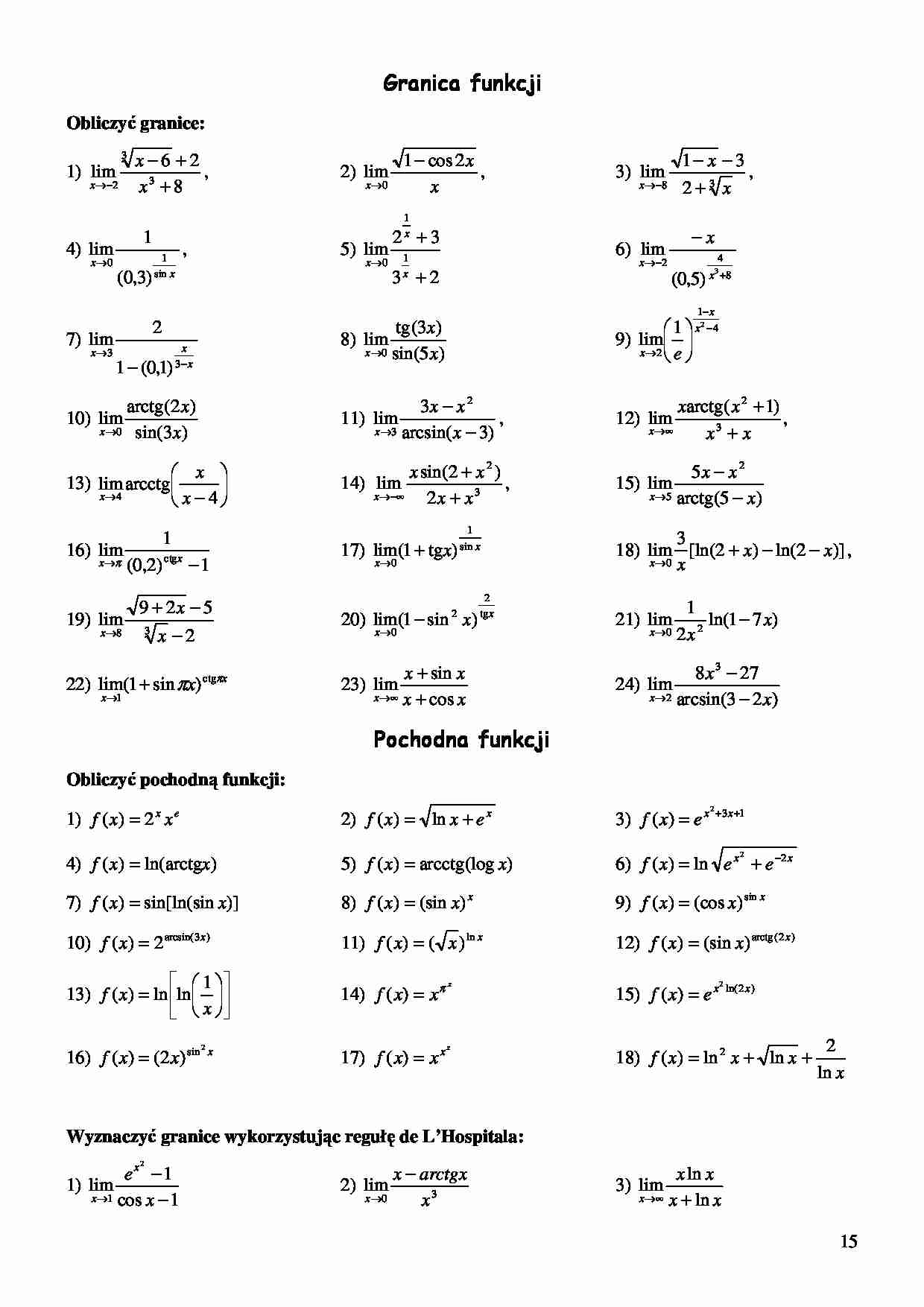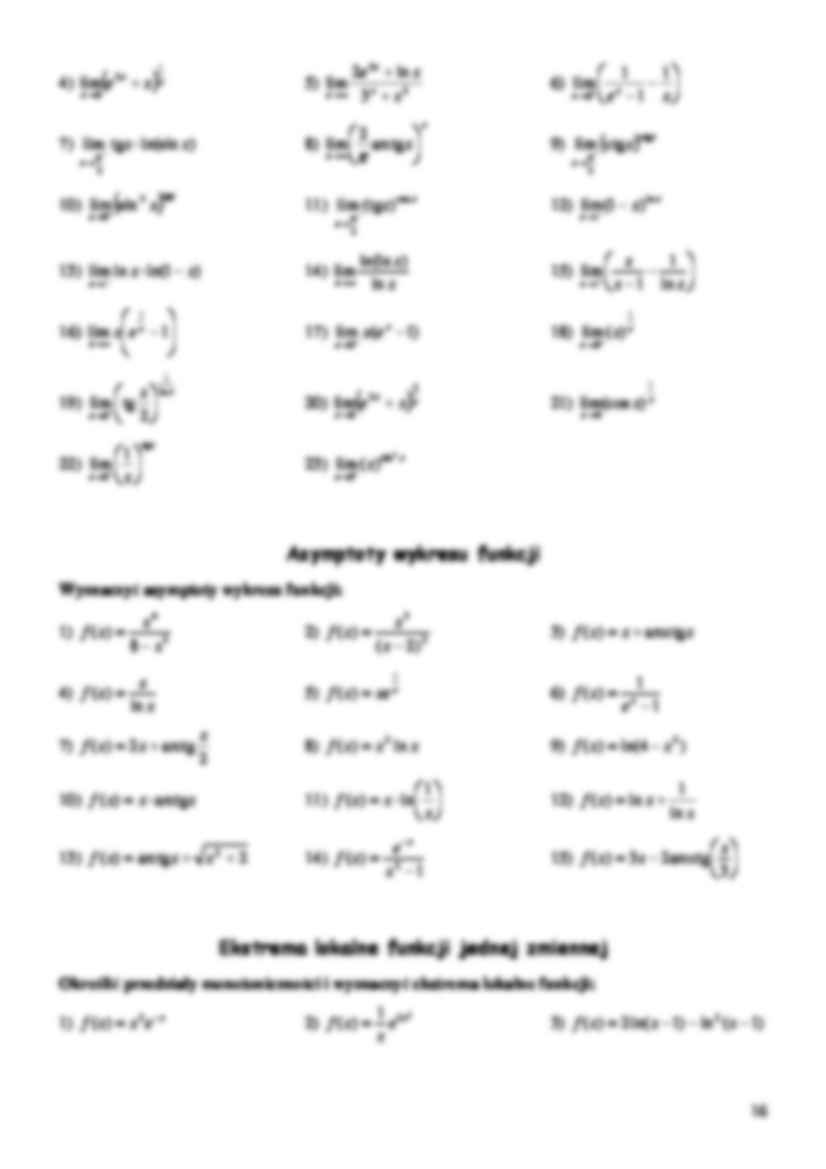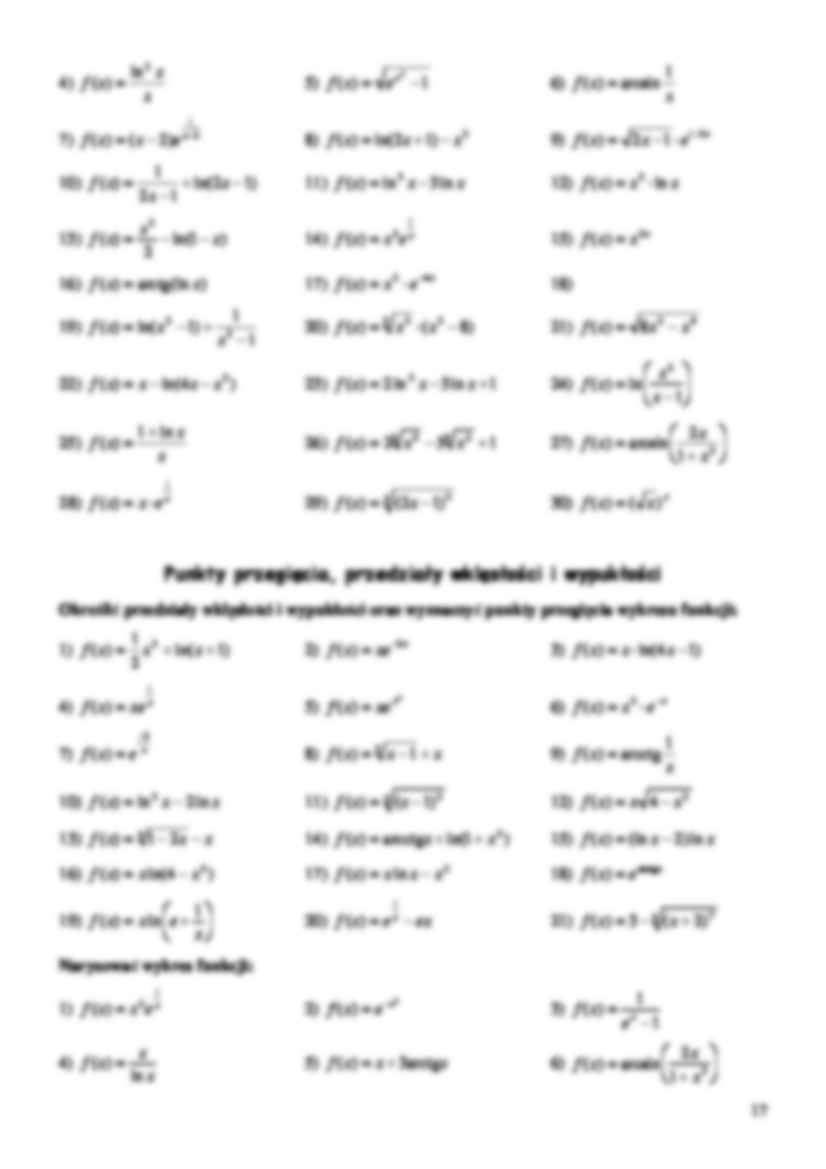To tylko jedna z 3 stron tej notatki. Zaloguj się aby zobaczyć ten dokument.
Zobacz
całą notatkę



Granica funkcji Obliczyć granice: 3 x − 6 + 2 1 − cos 2 x 1 − x − 3 1) lim , 2) lim , 3) lim , 3 x → 2 − x + 8 x →0 x x → 8 − 3 2 + x 1 1 2 x + 3 − x 4) lim , 5) lim 6) lim x 1 →0 1 x →0 4 x → 2 − sin x ( ) 3 , 0 3 x + 2 3 x +8 ( ) 5 , 0 1− x 2 tg 3 ( x ) 2 1 x −4 7) lim 8) lim 9) lim x x →3 x →0 sin 5 ( x ) x →2 e − x 1 − 3 ( ) 1 , 0 arctg(2 x ) 3 2 x − x x arctg( x 2 + ) 1 10) lim 11) lim , 12) lim , x →0 sin 3 ( x ) x →3 arcsin( x − ) 3 x →∞ x 3 + x x 2 x sin(2 + x ) 5 2 x − x 13) lim arcctg 14) lim , 15) lim x →4 x − 4 3 x →−∞ 2 x + x x →5 arctg 5 ( − x ) 1 1 3 16) lim 17) x lim 1 ( + tg x sin ) 18) lim [ln 2 ( + x ) − ln(2 − x )], → ( , 0 2)ctg x x π −1 x →0 x →0 x 2 9 + 2 x − 5 1 19) lim 20) 2 x lim 1 ( − sin x tg ) 21) lim ln 1 ( − 7 x ) x 8 → 3 x − 2 x →0 x → 2 2 0 x x + sin x 8 3 x − 27 22) x lim 1 ( + sin x π π ctg ) 23) lim 24) lim x 1 → x →∞ x + cos x x →2 arcsin 3 ( − 2 x ) Pochodna funkcji Obliczyć pochodną funkcji: 2 1) x e f ( x ) = 2 x 2) x f ( x ) = ln x + e 3) x +3 1 f ( x ) + = x e 2 4) f ( x ) = ln a ( rctg x ) 5) f ( x ) = arcctg(log x ) 6) x −2 x f ( x ) = ln e + e 7) f ( x ) = sin[ln(sin x )] 8) x f ( x ) = (sin x ) 9) sin x f ( x ) = (cos x ) 10) arcsin(3 x ) f ( x ) = 2 11) ln x f ( x ) = ( x ) 12) arctg(2 x ) f ( x ) = (sin x ) 1 x 2 13) f ( x ) = ln π ln 14) f ( x ) = x 15) x ln( 2 x ) f ( x ) = e x 2 x 2 2 16) sin x f ( x ) = (2 x ) 17) x f ( x ) = x 18) f ( x ) = ln x + ln x + ln x Wyznaczyć granice wykorzystując regułę de L’Hospitala: 2 e x −1 x − arctgx x ln x 1) lim 2) lim 3) lim x 1 → cos x −1 3 x →0 x x →∞ x + ln x 15 1 3 2 e x + ln x 1 1 4) lim( 2 x e + x ) x 5) lim
(…)
… − 3 ln x + 1
x2
24) f ( x) = ln
x −1
26) f ( x) = 23 x 5 − 53 x 2 + 1
2x
27) f ( x) = arcsin
2
1+ x
29) f ( x) = 3 (2 x − 1) 2
30) f ( x) = ( x ) x
19) f ( x) = ln( x 2 − 1) +
3
1
x −1
2
22) f ( x) = x − ln(4 x − x )
2
25) f ( x) =
1 + ln x
x
28) f ( x) = x ⋅ e
1
x
2
15) f ( x) = x 2 x
Punkty przegięcia, przedziały wklęsłości i wypukłości
Określić przedziały wklęsłości i wypukłości oraz wyznaczyć punkty przegięcia wykresu funkcji:
1) f ( x) =
1 2
x + ln( x + 1)
2
4) f ( x) = xe
7) f ( x) = e
−2
x
3) f ( x) = x ⋅ ln(4 x − 1)
5) f ( x) = xe x
1
x
2) f ( x) = xe −2 x
6) f ( x) = x 2 ⋅ e − x
2
1
x
8) f ( x) = 3 x − 1 + x
9) f ( x) = arcctg
10) f ( x) = ln 2 x − 2 ln x
11) f ( x) = 3 ( x − 1) 2
12) f ( x) = x 4 − x 2
13) f ( x) = 3 1 − 2 x − x
14) f ( x) = arcctgx + ln(1 + x 2 )
15) f ( x) = (ln x − 2) ln x
16) f ( x) = x ln(4 − x 2 )
17) f ( x) = x ln x − x 2
18) f ( x) = e arctgx
1
19) f ( x) = x ln e +
x
20) f ( x) = e x − ex
21) f ( x) = 3 − 5 ( x + 2) 7
2) f ( x) = e − x
3) f ( x) =
1
Narysować wykres funkcji:
1
1) f ( x) = x 2 e x
4) f ( x) =
x
ln x
2
5) f ( x) = x + 3arctgx
1
e −1
x
2x
6) f ( x) = arcsin
2
1+ x
17
…
…+ tg
x→0
2
1
22) lim
+
x →0 x
(
20) lim e
x →0
2x
+x
)
2
x
x →0
21) lim(cos x)
1
x
x →0
tgx
23) lim ( x) sin
+
2
x
x →0
Asymptoty wykresu funkcji
Wyznaczyć asymptoty wykresu funkcji:
1) f ( x) =
x4
8 − x3
2) f ( x) =
4) f ( x) =
x
ln x
5) f ( x) = xe x
6) f ( x) =
8) f ( x) = x 2 ln x
9) f ( x) = ln(4 − x 2 )
10) f ( x) = x ⋅ arctgx
1
11) f ( x) = x ⋅ ln
x
12) f ( x) = ln x +
13…
…+ tg
x→0
2
1
22) lim
+
x →0 x
(
20) lim e
x →0
2x
+x
)
2
x
x →0
21) lim(cos x)
1
x
x →0
tgx
23) lim ( x) sin
+
2
x
x →0
Asymptoty wykresu funkcji
Wyznaczyć asymptoty wykresu funkcji:
1) f ( x) =
x4
8 − x3
2) f ( x) =
4) f ( x) =
x
ln x
5) f ( x) = xe x
6) f ( x) =
8) f ( x) = x 2 ln x
9) f ( x) = ln(4 − x 2 )
10) f ( x) = x ⋅ arctgx
1
11) f ( x) = x ⋅ ln
x
12) f ( x) = ln x +
13) f ( x) = arctgx + x 2 + 2
14) f ( x) =
7) f ( x) = 2 x + arctg
x3
( x − 2) 2
3) f ( x) = x + arcctgx
1
x
2
e−x
x2 −1
1
e −1
x
1
ln x
x
15) f ( x) = 3 x − 2arcctg
3
Ekstrema lokalne funkcji jednej zmiennej
Określić przedziały monotoniczności i wyznaczyć ekstrema lokalne funkcji:
1) f ( x) = x 3 e − x
2) f ( x) =
1 2 x2
e
x
3) f ( x) = 2 ln( x − 1) − ln 2 ( x − 1)
16
4) f ( x) =
ln 2 x
x
6) f…
... zobacz całą notatkę






Komentarze użytkowników (0)